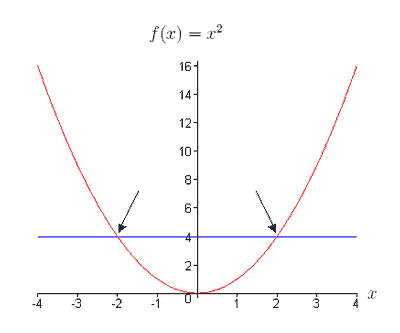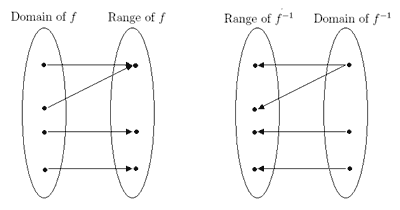Functions
Inverse Functions
|
You probably know that the inverse of addition is subtraction and the inverse of multiplication is division. Not only do mathematical operations have inverses, but some functions do as well. Understanding inverse functions will help you solve some of the equations that you will encounter in the life sciences. For instance, you many have a function that tells you the frequency of an allele in a population at a given point in time. But suppose you want to know the time that corresponds to a particular frequency solving this problem involves finding the inverse of the original function. Definition and Examples Consider a function f (x). We can think of f as an operation on the variable x (where x is a real number). In other words, we have some variable x which we input into f, and f outputs a new variable y. For example, f (x) = 2x operates by multiplying the input x by two. The output of this function is y = 2x. Is this operation reversible? In our example, the answer is clearly yes. If we multiply some number by 2, we can always divide the resulting number by two to recover our original number. Therefore, the function f(x) = 2x is said to be invertible.
We denote the inverse of f by f -1. Graphically, f(x) and f -1(x) are related in the sense that the graph of f -1(x) is a reflection of f(x) across the line y = x. Recall that the line y = x is the 45° line that runs through quadrants I and III. In addition, if f and f -1 are inverse functions, the domain of f is the range of f -1and vice versa. If the point (a, b) lies on the graph of f, then point (b, a) lies on the graph of f -1. How to determine if a function has an inverse. For a function to have an inverse, different inputs must correspond to different outputs. Such functions are said to be one-to-one (commonly denoted as 1-1) ,
Consider the function
If we input x =4, then f (4) = (4) 2= 16. Similarly, if we input x = -4, then f (-4) = (-4) 2= 16. As you can see, two different inputs, 4 and -4, give rise to the same output, 16. This shows that the function f (x) = x 2 is NOT one-to-one, and therefore cannot have an inverse. Another way to prove to yourself that f (x) = x 2 does not have an inverse is to ask the question, "can we recover -4 from 16?" One way we could recover -4 from 16 is to take - √16. Now suppose we input x = 4 into the same function. f (4) also equals 16. We can recover 4 by taking the square root of 16. This creates a problem; in order to recover the two legitimate input values from the function f (x) = x 2, two different operations were used. In this case, the reverse operation is ambiguous, it could be either √ or -√, showing that the operation of squaring a number is not consistently reversible. Therefore, the function f (x) = x 2 does NOT have an inverse. There is also a simple graphical way to test whether or not a function is one-to-one, and thus invertible, the horizontal line test. If a horizontal line intersects the graph of f in more than one place, then f is not one-to-one and fails the horizontal line test. The figure below shows that a horizontal line intersects the graph of f (x) = x 2 in more than one place, and thus the function fails the horizontal line test.
Finding a Symbolic Representation for f--1(x). For certain functions, we can write a symbolic representation of the inverse function. Suppose we have a function y = f (x), which we know to be invertible. To attempt to find a formula for y = 3x -7. If you graph this function you will see that it is a line, passes the horizontal line test, and thus is invertible. To find symbolic representation of f--1(x), we switch the variables x and y as follows, x = 3y - 7. To find the inverse, we must now solve the above equation for y as, y = (x + 7)/3. Therefore, we can write f--1(x) = (x + 7)/3 as the symbolic representation of f's inverse. Now consider the function, f (x) = x2, Switching the variables x and y, we run into the following problem, x = y2, y = ±√x. In this case, we switched the variables, solved for y, and found an ambiguity. In our attempt to symbolically represent f -1 resulted in the equation y = ±√x, which is NOT a function because one input corresponds to two outputs. This example further illustrates why a function must be one-to-one to be invertible. Furthermore, because the domain and range of inverse functions exchange, the fact that different inputs produce the same output for f results in one input producing different outputs for f--1 as depicted in the figure below.
Unfortunately, we cannot always find the symbolic representation for a function that is invertible. Consider the following function, f (x) = y = x3 + 2x2 + 3x +1. This function passes the horizontal line test and is thus invertible.
To find symbolic representation for f -1, we switch the variables x and y, x = y3 + 2y2 + 3y +1, and solve for y. In this complicated case, we cannot write y = f -1 as an explicit function of x. Although f -1(x) exists, we cannot write a symbolic expression in terms of the variable x to represent it. Finding an inverse by restricting the domain While we cannot find the inverse of a function that is not one-to-one, often we can find the inverse of such functions by restricting the domain. Returning to our example, the function f (x) = x2, is not one-to-one, but becomes a one-to-one function if we restrict the domain to non-negative real numbers {x| x ≥ 0}. By restriction the domain to this set, f -1(x) = √x. Likewise, if we restrict the domain to all non-positive real numbers {x| x ≤ 0}, then f -1(x) = - √x. ***** Now try some problems that will test your understanding of functions. |
The Biology Project > Biomath > Function > Inverse
Department of Biochemistry and Molecular Biophysics
The University of Arizona
January 2006
Contact the Development Team
http://www.biology.arizona.edu
All contents copyright © 2006. All rights reserved.


